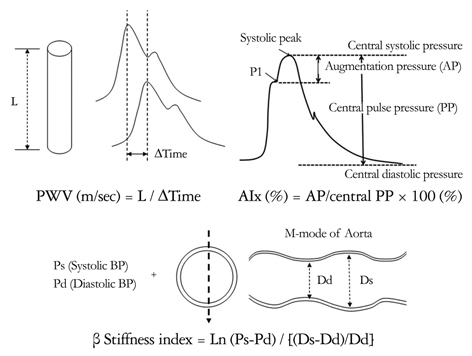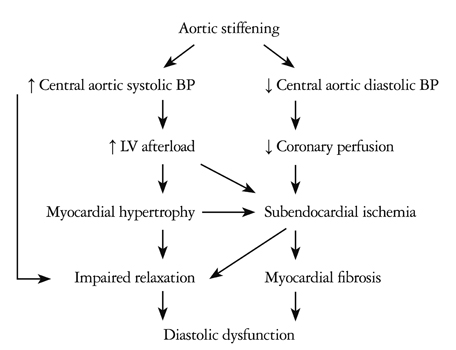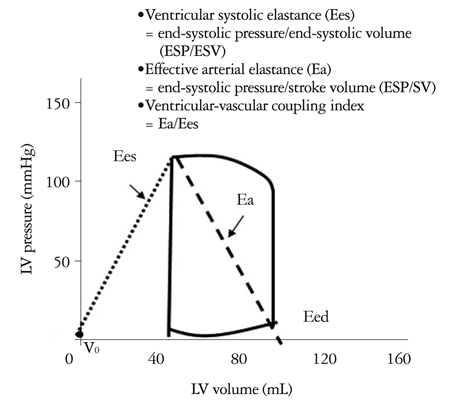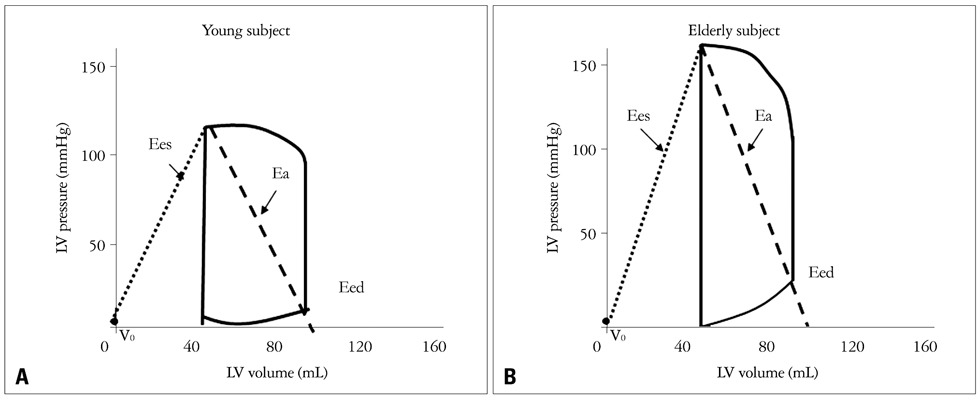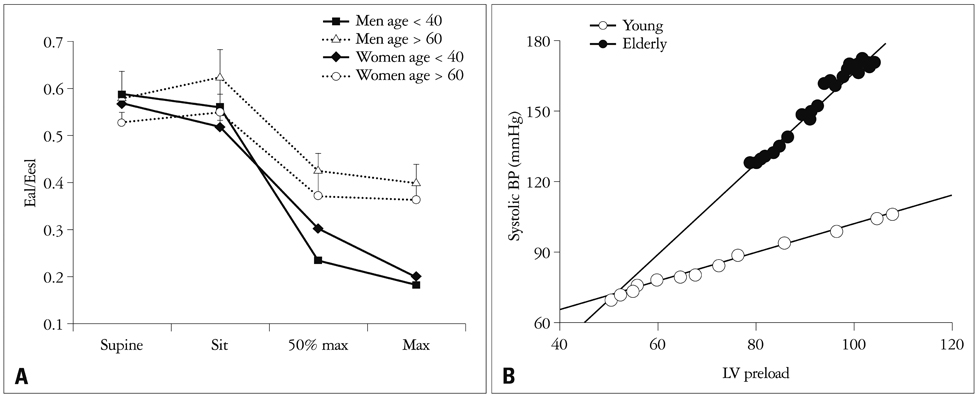J Cardiovasc Ultrasound.
2011 Jun;19(2):62-66. 10.4250/jcu.2011.19.2.62.
Arterial-Cardiac Interaction: The Concept and Implications
- Affiliations
-
- 1Cardiology Division, Severance Cardiovascular Hospital, Yonsei University College of Medicine, Seoul, Korea. cysprs@yuhs.ac
- KMID: 1980352
- DOI: http://doi.org/10.4250/jcu.2011.19.2.62
Abstract
- Vascular stiffening of the large arteries is a common feature of human aging. Increased aortic stiffness with age may contribute to pathological changes in the left ventricle and this can induce ventricular stiffening. Vascular-ventricular stiffening combined with abnormal arterial-cardiac interaction is considered an important pathophysiology of heart failure with a preserved ejection fraction. Here, I briefly review the concept and implications of arterial-cardiac interaction and this will pave the way to understanding and controlling heart failure with a preserved ejection fraction, which is more prevalent in the elderly.
Keyword
Figure
Cited by 1 articles
-
Heart Failure with Preserved Ejection Fraction: the Major Unmet Need in Cardiology
Chi Young Shim
Korean Circ J. 2020;50(12):1051-1061. doi: 10.4070/kcj.2020.0338.
Reference
-
1. Sunagawa K, Maughan WL, Burkhoff D, Sagawa K. Left ventricular interaction with arterial load studied in isolated canine ventricle. Am J Physiol. 1983. 245:H773–H780.
Article2. Starling MR. Left ventricular-arterial coupling relations in the normal human heart. Am Heart J. 1993. 125:1659–1666.
Article3. Kass DA. Age-related changes in venticular-arterial coupling: pathophysiologic implications. Heart Fail Rev. 2002. 7:51–62.4. Kass DA. Ventricular arterial stiffening: integrating the pathophysiology. Hypertension. 2005. 46:185–193.5. O'Rourke MF, Hashimoto J. Mechanical factors in arterial aging: a clinical perspective. J Am Coll Cardiol. 2007. 50:1–13.6. O'Rourke MF. Arterial aging: pathophysiological principles. Vasc Med. 2007. 12:329–341.7. Smulyan H, Asmar RG, Rudnicki A, London GM, Safar ME. Comparative effects of aging in men and women on the properties of the arterial tree. J Am Coll Cardiol. 2001. 37:1374–1380.
Article8. Choi CU, Kim EJ, Kim SH, Shin SY, Choi UJ, Kim JW, Lim HE, Rha SW, Park CG, Seo HS, Oh DJ. Differing effects of aging on central and peripheral blood pressures and pulse wave velocity: a direct intraarterial study. J Hypertens. 2010. 28:1252–1260.
Article9. McEniery CM, Yasmin , Hall IR, Qasem A, Wilkinson IB, Cockcroft JR. ACCT Investigators. Normal vascular aging: differential effects on wave reflection and aortic pulse wave velocity: the Anglo-Cardiff Collaborative Trial (ACCT). J Am Coll Cardiol. 2005. 46:1753–1760.
Article10. Antonini-Canterin F, Carerj S, Di Bello V, Di Salvo G, La Carrubba S, Vriz O, Pavan D, Balbarini A, Nicolosi GL. Research Group of the Italian Society of Cardiovascular Echography (SIEC). Arterial stiffness and ventricular stiffness: a couple of diseases or a coupling disease? A review from the cardiologists point of view. Eur J Echocardiogr. 2009. 10:36–43.
Article11. Laurent S, Cockcroft J, Van Bortel L, Boutouyrie P, Giannattasio C, Hayoz D, Pannier B, Vlachopoulos C, Wilkinson I, Struijker-Boudier H. European Network for Non-invasive Investigation of Large Arteries. Expert consensus document on arterial stiffness: methodological issues and clinical applications. Eur Heart J. 2006. 27:2588–2605.
Article12. Kelly R, Hayward C, Avolio A, O'Rourke M. Noninvasive determination of age-related changes in the human arterial pulse. Circulation. 1989. 80:1652–1659.
Article13. Benetos A, Thomas F, Joly L, Blacher J, Pannier B, Labat C, Salvi P, Smulyan H, Safar ME. Pulse pressure amplification a mechanical biomarker of cardiovascular risk. J Am Coll Cardiol. 2010. 55:1032–1037.14. Nijdam ME, Plantinga Y, Hulsen HT, Bos WJ, Grobbee DE, van der Schouw YT, Bots ML. Pulse pressure amplification and risk of cardiovascular disease. Am J Hypertens. 2008. 21:388–392.
Article15. Hirai T, Sasayama S, Kawasaki T, Yagi S. Stiffness of systemic arteries in patients with myocardial infarction. A noninvasive method to predict severity of coronary atherosclerosis. Circulation. 1989. 80:78–86.
Article16. Mottram PM, Haluska BA, Leano R, Carlier S, Case C, Marwick TH. Relation of arterial stiffness to diastolic dysfunction in hypertensive heart disease. Heart. 2005. 91:1551–1556.
Article17. Weber T, Auer J, O'Rourke MF, Punzengruber C, Kvas E, Eber B. Prolonged mechanical systole and increased arterial wave reflections in diastolic dysfunction. Heart. 2006. 92:1616–1622.
Article18. Shim CY, Park S, Choi D, Yang WI, Cho IJ, Choi EY, Chung N, Ha JW. Sex differences in central hemodynamics and their relationship to left ventricular diastolic function. J Am Coll Cardiol. 2011. 57:1226–1233.
Article19. Borlaug BA. Sex, load, and relaxation: are women more susceptible to load-dependent diastolic dysfunction? J Am Coll Cardiol. 2011. 57:1234–1236.20. Myhre ES, Johansen A, Piene H. Optimal matching between canine left ventricle and afterload. Am J Physiol. 1988. 254:H1051–H1058.
Article21. Elzinga G, Westerhof N. Matching between ventricle and arterial load. An evolutionary process. Circ Res. 1991. 68:1495–1500.
Article22. Devereux RB, Alonso DR, Lutas EM, Gottlieb GJ, Campo E, Sachs I, Reichek N. Echocardiographic assessment of left ventricular hypertrophy: comparison to necropsy findings. Am J Cardiol. 1986. 57:450–458.
Article23. Kelly RP, Ting CT, Yang TM, Liu CP, Maughan WL, Chang MS, Kass DA. Effective arterial elastance as index of arterial vascular load in humans. Circulation. 1992. 86:513–521.
Article24. Chen CH, Nakayama M, Nevo E, Fetics BJ, Maughan WL, Kass DA. Coupled systolic-ventricular and vascular stiffening with age: implications for pressure regulation and cardiac reserve in the elderly. J Am Coll Cardiol. 1998. 32:1221–1227.25. Nitenberg A, Loiseau A, Antony I. Left ventricular mechanical efficiency in hypertensive patients with and without increased myocardial mass and with normal pump function. Am J Hypertens. 2001. 14:1231–1238.
Article26. Asanoi H, Kameyama T, Ishizaka S, Miyagi K, Sasayama S. Ventriculoarterial coupling during exercise in normal human subjects. Int J Cardiol. 1992. 36:177–186.
Article27. Najjar SS, Schulman SP, Gerstenblith G, Fleg JL, Kass DA, O'Connor F, Becker LC, Lakatta EG. Age and gender affect ventricular-vascular coupling during aerobic exercise. J Am Coll Cardiol. 2004. 44:611–617.
Article
- Full Text Links
- Actions
-
Cited
- CITED
-
- Close
- Share
- Similar articles
-
- Concept Analysis of Mother-Child Interaction
- Concept Analysis of Cardiac Arrest: Identifying the Critical Attributes and Empirical Indicators
- Problems in Cardiac Output Measurement and Clinical Understanding
- Arterial Stiffness in the Young: Assessment, Determinants, and Implications
- Interpretation of the hygiene and microflora hypothesis for allergic diseases through epigenetic epidemiology

